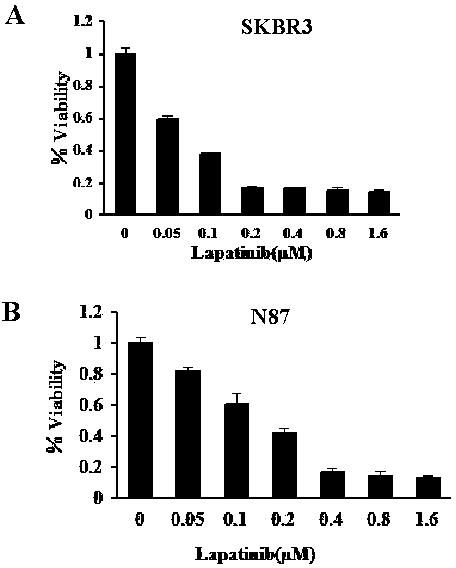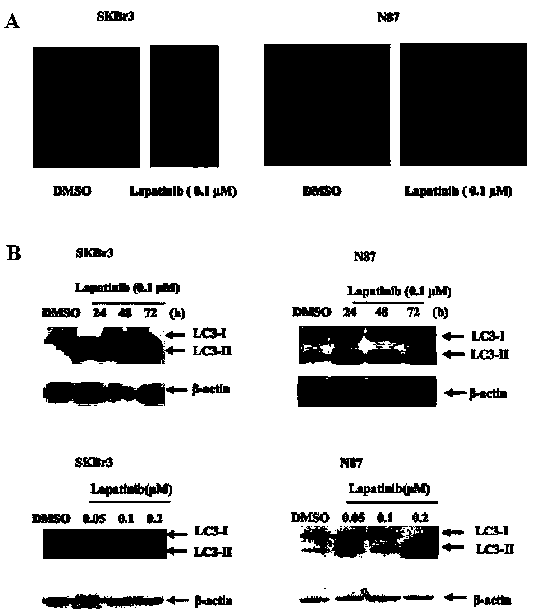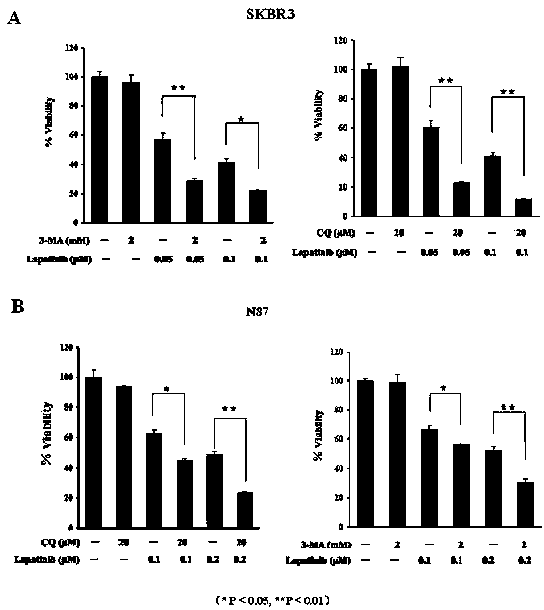Composition of autophagy inhibitor and lapatinib, and application thereof
An autophagy inhibitor, lapatinib technology, applied in the field of medicine, can solve problems such as undiscovered combination administration, and achieve the effect of enhancing the therapeutic effect
- Summary
- Abstract
- Description
- Claims
- Application Information
AI Technical Summary
Problems solved by technology
Method used
Image
Examples
Embodiment 1
[0037] Example 1: Preparation of autophagy inhibitor drugs
[0038](1) Preparation of chloroquine: Dissolve an appropriate amount of chloroquine in pure water to make a 10mmol / L storage solution, filter and sterilize it with a 0.1μM filter, and store it at 4°C. Dilute 500-1000 times with PRMI-1640 medium for in vitro experiments. to inhibit autophagy;
[0039] (2) Prepare ammonium chloride: Dissolve an appropriate amount of ammonium chloride in water to make a 0.4mol / L storage solution, filter and sterilize with a 0.1μM filter and store at 4°C; dilute 50-80 times for in vitro experiments Inhibit autophagy;
[0040] (3) Preparation of hydroxychloroquine: Dissolve an appropriate amount of hydroxychloroquine in pure water to make a 10mmol / L storage solution, filter and sterilize with a 0.1μM filter, store at 4°C, dilute 500-1000 times in an in vitro laboratory to inhibit cells Autophagy;
[0041] (4) Preparation of 3-MA: Take an appropriate amount of 3-MA dry powder to prepa...
Embodiment 2
[0045] Example 2: Cell Culture
[0046] Breast cancer SKBR3 cells and gastric cancer N87 cells were cultured using PRMI-1640 medium containing 10% FBS and 1% penicillin-streptomycin; 5 The concentration of cells / mL was transferred to the cell culture plate for culture, and after 12 hours of culture, the cells in each group were given corresponding concentrations of lapatinib; for combined administration, 20 μM CQ or 2 mM 3-MA was added 1 hour before administration Inhibit the autophagy of SKBR3 and N87 cells; after continuous culture for 24 h, 48 h or 72 h, proceed to the next step.
Embodiment 3
[0047] Example 3: Lapatinib can inhibit the proliferation of SKBR3 and N87 cells
[0048] Plant SKBR3 and N87 cells of appropriate concentration in a 96-well culture plate, add lapatinib to make the final concentration of lapatinib 0-1.6 μM, culture for 48 h, add 10 μL MTT solution to each well, and place in the incubator Leave it for 4 h, then dissolve it with DMSO solution, measure the optical density value (O.D.) at 570nm, the result is as follows figure 1 As shown in A and B, lapatinib has good efficacy on SKBR3 and N87 cells and lapatinib has a good dose-dependent killing effect on SKBR3 and N87 cells.
PUM
 Login to View More
Login to View More Abstract
Description
Claims
Application Information
 Login to View More
Login to View More - R&D
- Intellectual Property
- Life Sciences
- Materials
- Tech Scout
- Unparalleled Data Quality
- Higher Quality Content
- 60% Fewer Hallucinations
Browse by: Latest US Patents, China's latest patents, Technical Efficacy Thesaurus, Application Domain, Technology Topic, Popular Technical Reports.
© 2025 PatSnap. All rights reserved.Legal|Privacy policy|Modern Slavery Act Transparency Statement|Sitemap|About US| Contact US: help@patsnap.com



